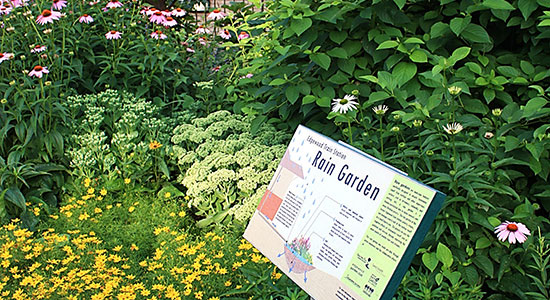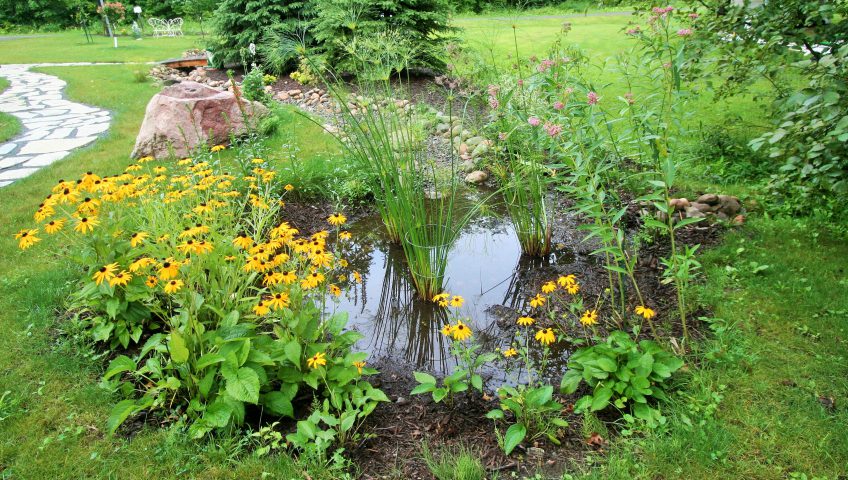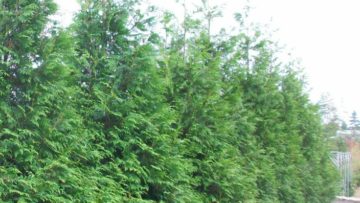A growing trend in the modern landscape is the rain garden. These purposeful planting beds are designed to help stem runoff after heavy storms or control problem wet spots. They also serve as more natural drainage alternatives to french drain or other mechanical fixes.
A good rain garden is environmentally-friendly first and foremost, but provides additional appeal to your landscape in unexpected places.
Take in our quick overview of these features here and find out if a rain garden is the answer to your water control problems.
Rain Garden Basics: Controlling Wastewater
Primarily a water control feature, rain gardens are naturalized planting beds that help excess water percolate into the soil and evaporate into the atmosphere.
Urbanization and paving have replaced much of our habitat with impermeable surfaces, directing more and more water into increasingly stressed waterways like storm drains and sewer systems. A heavy downpour or sustained rainy season can overload these systems and carry toxins like road debris and turf fertilizers into our water cycle.
Even lawns and other green spaces can contribute to harmful runoff if designed improperly.
A rain garden makes use of careful soil structure and select plant material to keep excess runoff from entering the water cycle, allowing water to both seep naturally into the ground and evaporate following a storm.
Creating an effective rain garden can be a relatively pain-free solution to excessive water problems. It’s also an opportunity to bring color and plant life to areas of your landscape that might otherwise be overlooked.
So, what to look for in a good rain garden?

Location, Location
Rain gardens and other forms of bioretention are only successful if placed properly in the landscape.
You’ll want to select an area at least 10 feet from any structures. By design, these gardens leech water slowly back into the soil. With buildings of any type, that’s bad news for the foundation. Place your garden far enough from critical structures that leakage and frost pressure won’t be an issue.
If runoff is creating a problem wet spot in your yard, this might be the place to install your new garden. In most cases, work with gravity. Rain gardens are effective when placed in depressions and naturally occurring low spots.
If no such low spots are naturally occurring, a ‘swale,’ or bowl-shaped depression in the landscape, can be created and is the perfect place to plant your rain garden.
Plant Selection
Most critical to the success of your rain garden is the soil structure built below the garden itself — you can read into proper soil types in more depth here — but the most apparent part of your garden will be above ground.
Water-loving plants are the most obvious candidates for a rain garden. You’ll also want to select native plants — or plants that naturally occur in your region.
For the Pittsburgh area (and most of the Northeast), that means a good selection of herbacious perennials and some ornamental grasses. Lobelia, Rudbeckia (coneflower) and some Geraniums can work well in your garden. Woodier shrubs and trees like Elderberry, Ninebark, some Dogwoods and Wild Hydrangea are options as well.
(Rain Gardens can also serve as pollinator gardens. Many of these plants will naturally attract bees, birds and other wildlife that can get pushed out of their habitat by urbanization.)
Be sure to check for water-tolerance in your rain garden plants, as well as an ability to thrive during dry spells when your rain garden may go dry for days or weeks at a time.
Ditch the Ditch
If you’re looking to help control problem runoff or address a stubborn wet spot in your yard, consider a rain garden as an alternative to messy and disruptive drain installations.
Our design and installation team can work with you to locate the proper placement and plantings for your rain garden, and help bring color and utility to your landscape in one project.
For even more information on rain gardens, consult the Three Rivers Rain Garden Alliance. This Pittsburgh-based organization has plenty of resources to help you consider the best way to plan and plant your next rain garden, tracks the performance of your garden as a wastewater control system and puts you on the map as helping to keep Pittsburgh’s waterways clean.



